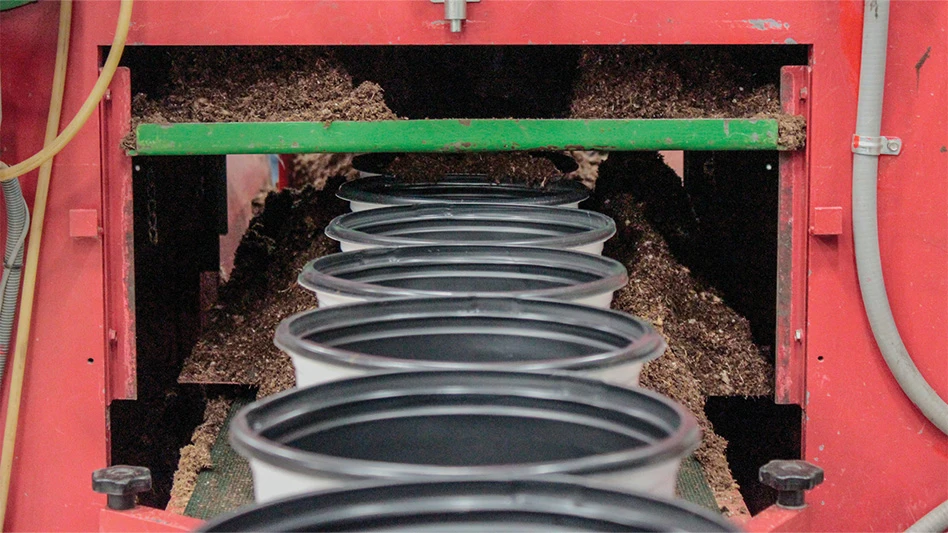

Year after year, growers report that thrips, aphids and spider mites are the most problematic pests in the greenhouse. From beneficial insects to proper scouting and sanitation, there are many things you can do to manage these three threats with biological controls. We spoke with Alex Traven, head grower at Peace Tree Farm in Kintnersville, Pennsylvania, about best practices.
No matter what pests you’re dealing with, weed control is an absolute must, Traven says. He’s noticed that wherever you have leaks, you’re going to have weeds, and with weeds come bugs. So when Peace Tree Farm is shutting down its greenhouses, he drains all of the plumbing and makes sure that there are no wet spots left.
“Otherwise you’ll have weeds growing in there that nobody knows about until you go in to refill that house and find that you’ve already got bugs in there,” Traven says.
While biological controls are great at controlling pest populations where they are, they don’t eradicate them, Traven says, so it’s crucial to start off on the right foot. “So if you’re starting with a very, very low population that’s below your economic threshold, a good biological control program will keep it there. But if you’re already to the point where you’ve got damage or a very high population, you won’t really be able to catch up to it,” he says.

Controlling thrips
Thrips are a perennial issue for greenhouses and Traven is always on watch for them. “My assumption from day one with every single thing is that there are thrips there,” he says. “I’ve never really felt like I was able to exclude them from anything.”
If you’re using a biological control program, it’s critical to get them early on in their life cycle and prevent them from building up a population. “You don’t wait and see on thrips. If you wait and see on thrips, you’re done,” he says.
It’s incredibly difficult to control adult thrips with beneficial insects since many predatory mites or beneficial nematodes only target the pest in certain life stages, so timing is everything. Traven will even change the dates of his bug deliveries to make sure that predatory mites are being applied the day after Peace Tree is sticking cuttings.
“When you’re talking about these really short life stages of insects — that can be a two- or three-day window that you can really control them. You can miss that entire window of control with bio-controls if you’re waiting a week before applying,” he says.
Identifying aphids
Instead of looking for aphids themselves, Traven recommends telling employees (especially less experienced workers) to scout for aphid damage, which is much easier to spot.
“They’re much more likely to notice the shininess of the honeydew that they excrete or the white molted skins than they are to see the very cryptically colored small aphids that might be there,” he says.
Identification is key when it comes to biological aphid control, Traven says. But, “It’s not as easy as one would suspect.”
Growers often assume that whatever species of plant you find an aphid on defines the type of aphid. For example, an aphid on lettuce is always a lettuce aphid.
“But that’s not true at all,” Traven says. “There are many different types of aphids that have different hosts that they like or don’t like. And then on top of that, there’s different parasites and organisms that will control those aphids, but some of them are species-specific.”

Fighting spider mites
Spider mites don’t fly like thrips or aphids, but they’re “astonishingly mobile,” Traven says. There’s a lot you can do to control them with proper sanitation practices, but once they get into the greenhouse, they don’t hesitate to climb up posts and basket lines and make their way across drip lines.
To spot them, look for damage at the tips of the plants rather than spider mites themselves.
One of the things Traven has found is that environmental conditions can favor the predators in the fight against spider mites. “You can’t just rely on one organism through the entire growing season,” he says. “You may need to switch when the weather switches.”
But the main thing to remember is to clean thoroughly in the off-season to keep spider mites from overwintering and then exploding in population once the temperatures get warmer.

Bringing in chemicals
If you’re dealing with a biological control program like Peace Tree Farm, you’ll also have to take a look at the interactions between chemical applications and your beneficial insects. At a certain point, Traven says you have to make sure that you’re looking at the economic threshold of a crop and determining the best course of action to keep your plant at the quality it needs to be.
“If you don’t feel like it’s going to make it at the quality that you need, obviously you need to do what you need to do,” he says.
But be aware that the effects can be long-lasting to a biological program if you aren’t careful. There are certain conventional products that can be used to target specific pests without harming beneficial insects, but broad-spectrum sprays can wreak havoc on a program.
“It’s kind of a slippery slope of chemical use when you use a chemical to treat a crop where you have a beneficial insect program,” Traven says.
Say you’re protecting against five different pests and one of them gets to too high of a level. If you spray for that pest, you can kill the beneficial insects that are controlling the other four, Traven says. Suddenly, you’re looking at the other four pests growing without the control of the beneficial insects and needing to make a broad-spectrum application to get things under control.
“So there’s a real slippery slope once you start using chemicals that really tends to just shut down the program unless you’re using very specific targeted products,” Traven says.
Get curated news on YOUR industry.
Enter your email to receive our newsletters.
Explore the January 2020 Issue
Check out more from this issue and find your next story to read.
Latest from Greenhouse Management
- The HC Companies, Classic Home & Garden merge as Growscape
- Eason Horticultural Resources will now officially be known as EHR
- BioWorks receives EPA approval for new biological insecticide for thrips, aphids, whiteflies
- ScottsMiracle-Gro transfers cannabis subsidiary to focus on core lawn and garden business
- Ellen Mackenbach-Lakeman appointed new CEO of Dümmen Orange
- Southern Garden Tour sets 2025 dates for trial garden open houses
- Belgian thermal screen manufacturer Phormium launches Noctis Thermo
- New book explores plants that thrive in Rocky Mountains






